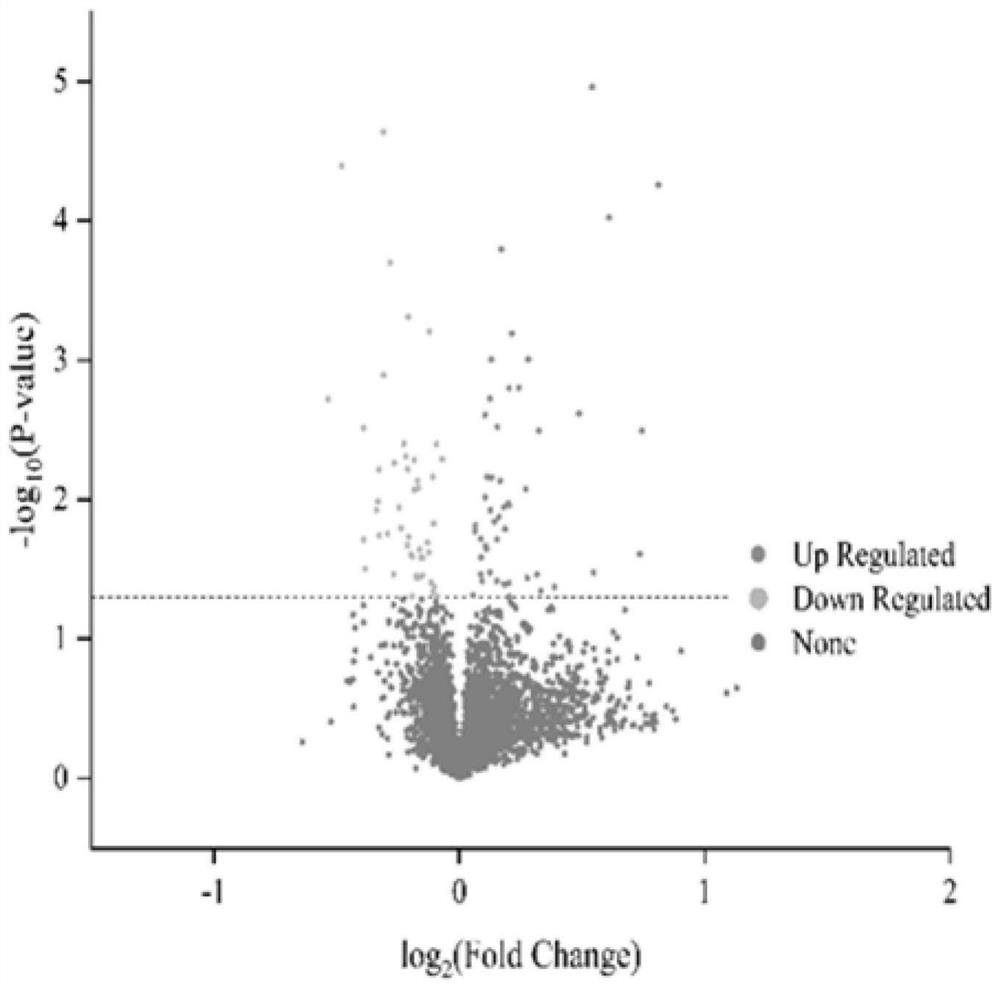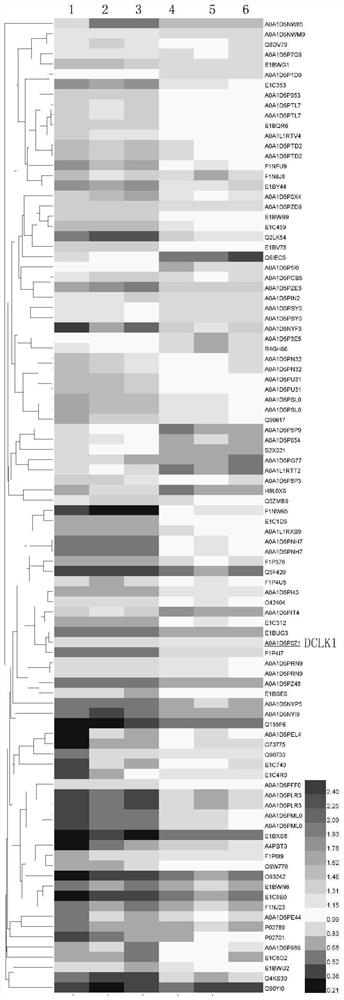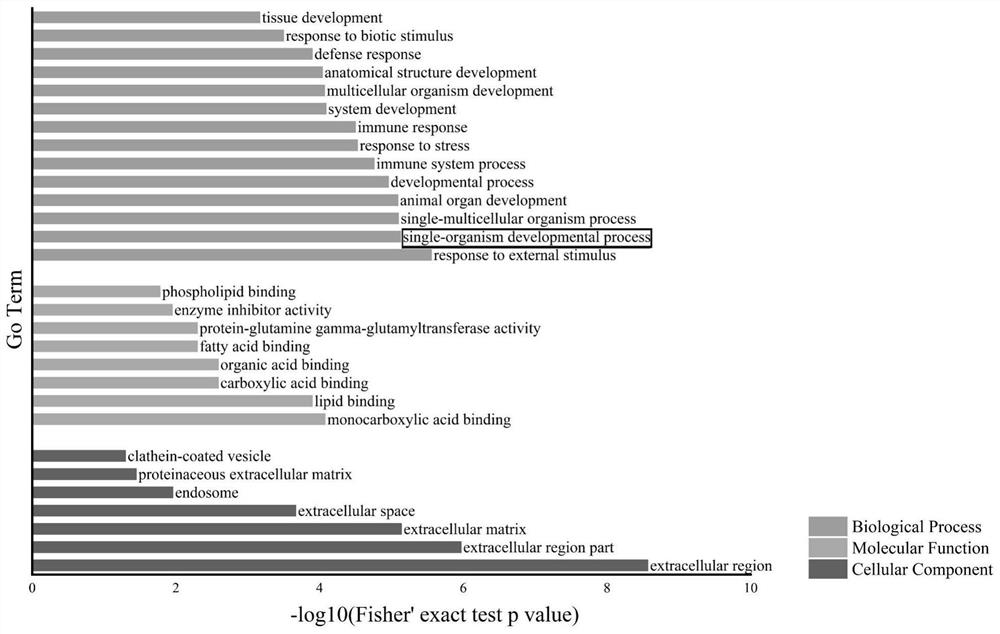New application of doublecortin-like kinase 1
An epinephrine-like kinase technology, applied in the field of virology, can solve the problems of increasing viral contact, low viral load, limiting the progress of ALV-J research, etc., to achieve the effect of promoting replication and prolonging S phase time
- Summary
- Abstract
- Description
- Claims
- Application Information
AI Technical Summary
Problems solved by technology
Method used
Image
Examples
Embodiment 1
[0051] Example 1 TMT quantitative proteomics screening and analysis of DF-1 cells infected with ALV-J
[0052] 1. Cell sample preparation
[0053] DF-1 cells were cultured at 25CM 2 In the cell culture flask, the cells were divided into 2 groups with 3 replicates in each group:
[0054] In group 1, when the fusion degree of DF-1 cells reaches 70%, add 1 mL of ALV-J venom and maintain for 2 hours, discard the venom in the cell bottle, add DMEM medium containing 1% FBS, and store at 37°C in 5% CO 2 Maintain in the incubator for 72 hours (preliminary experiments showed that DF-1 cells infected with ALV-J can reach the peak of ALV-J load for 72 hours);
[0055] Group 2, when the confluence of DF-1 cells reaches 70%, add DMEM containing 1% FBS, incubate at 37°C in 5% CO 2 The culture was maintained in the incubator for 72 hours.
[0056] 2. Protein extraction
[0057] After the cells were digested with trypsin, 4 times the volume of lysis buffer was added and lysed by sonicati...
Embodiment 2
[0077] Example 2 Activation of DCLK1 expression after ALV-J infects DF-1 cells
[0078] In order to study the effect of ALV-J infection on the expression of DCLK1, a DF-1 cell model infected with ALV-J was constructed in this example, and the expression of ALV-J and DCLK1 at 24, 48 and 72 hours were detected by qPCR and western blot, respectively.
[0079] 1. Design of fluorescent quantitative primers
[0080] According to the DCLK1 sequence published by Genbank accession number NM_001257257, the CDS sequence (272-2461) of the DCLK1 protein was obtained, and primers were designed, which were synthesized and verified by BGI. The primer sequences are as follows:
[0081] F-CCCAGGGAGTGAGAACAA-, shown in SEQ ID NO.5;
[0082] R-TACCTCCTTTAGCAGTAGCA-, shown in SEQ ID NO.6;
[0083] 2. Preparation of cell material
[0084] Inoculate DF-1 cells on a 12-well cell culture plate according to the specified cell density. 2 Cultivate in the incubator overnight; when the cell density re...
Embodiment 3
[0128] Example 3 DCLK1 interacts with SU protein of ALV-J
[0129] In order to clarify whether ALV-J recruits DCLK1 through the interaction of SU and DCLK1, this example carried out laser confocal experiments and co-immunoprecipitation analysis:
[0130] 1. Laser confocal detection of SU protein expression localization of DCLK1 and ALV-J
[0131] 1) Cell pretreatment: Cells were cultured in laser confocal plates, and the cultured cells were divided into two groups. In the first group, when the cells reached 70% confluence, they were infected with ALV-J and treated with DMEM containing 1% fetal bovine serum. The culture medium was maintained for 72 hours; in the second group, when the cells reached 70% confluence, they were replaced with DMEM medium containing 1% fetal bovine serum and maintained for 72 hours;
[0132] 2) Washing: Discard the medium in the plate, add 1 mL of preheated PBS to wash 3 times, and wash the residual medium and dead cells;
[0133] 3) Fix the cells:...
PUM
 Login to View More
Login to View More Abstract
Description
Claims
Application Information
 Login to View More
Login to View More - R&D
- Intellectual Property
- Life Sciences
- Materials
- Tech Scout
- Unparalleled Data Quality
- Higher Quality Content
- 60% Fewer Hallucinations
Browse by: Latest US Patents, China's latest patents, Technical Efficacy Thesaurus, Application Domain, Technology Topic, Popular Technical Reports.
© 2025 PatSnap. All rights reserved.Legal|Privacy policy|Modern Slavery Act Transparency Statement|Sitemap|About US| Contact US: help@patsnap.com



